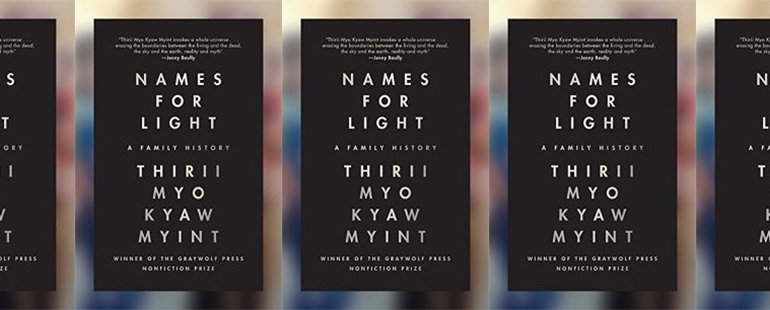Finding Home in Thirii Myo Kyaw Myint’s Names for Light

Thirii Myo Kyaw Myint’s Names for Light, winner of the 2018 Graywolf Nonfiction Prize, questions the meaning of home. The memoir gathers interwoven vignettes of past and present, examining themes of genealogy and displacement. Myint confronts the ambivalence of belonging and alienation, discussing colonial and post-colonial violence, racism, micro-aggressions, and othering, as well as her painful experience of marginalization in the United States, where she grew up, and abroad. From the unwanted touch of her skin to the inquisitorial curiosity of strangers over where she “really” comes from, she expresses her tiredness and understandable rage. In a climate of rising anti-Asian hate crimes, this book is an urgent call for change.
What immediately stands out in the urgent call is Myint’s clear voice, as she explores personal and historical issues through lyrical evocations of cities and town such as Yangon, Madrid, South Bend, Sittwe, and Hinthada. At first, the locations overlay in a dizzying recollection, each chapter taking place in a different setting, conveying the author’s sense of inherited and acquired displacement. But the varied geography is an invitation to remember lived experience despite uprootedness and, perhaps most importantly for Myint, provides a canvas on which to appose orally-transmitted heritage to re-center among constant movement.
To recreate this oral heritage, Myint creates dialogues with family and the ghosts of family no longer with her. She believes to have embodied the reincarnation of her great-grandfather. The memory of her elder brother, who died as a newborn, also never leaves her. Her elder sister, she believes, is the transmigrated soul of their great-grandmother. The evocation of her ancestors nods to the belief in the interconnectedness of all things and the difficulty of escaping one’s fate. Referring to an old photograph hung in the room which she used to share with her two sisters, Myint notes: “For many years, I looked at it as if looking into a mirror, as if by my looking I could conjure the ghosts of my great-grandfather and my great-grandmother. I looked and looked at this photograph until I felt as if we were the ghosts, my middle sister and I, we, the remnants of these people.”
Myint seeks to populate missing pieces of a family story, one which links her both to the intimacy of her great-grandfather and a sense of safety. Memory merges the emotional and physical when she recalls, like him, similar health woes, serving to carry a form of identification and projection, crucial to Myint’s own reconstructed narrative:
I do not know how much ash is produced when a body is burned. Ash is the remainder, the residue, the remnant or trace, the vestige of a body after it has burned. Ash is what could not burn, or what had to be created so something else could be destroyed. In this way, we are all each other’s ashes. I am my great-grandfather’s ash. I am the story that was told about his death, or the story that was created from his death, though many years later.
Here, Myint embraces a world of haunting recollections, omens, and traditions—including Buddhist teachings on the transience and non-binary nature of our existence and what to call home. Her family story is reclaimed and is revived through her.
Myint also shows that home is expressed not only in herself and her immediate family but also in geography—in land. Mynit intertwines the personal and the historical, writing about Myanmar’s own troubled history. Myint’s reflections on Myanmar and nationalism are timely and illuminating, given the military’s takeover earlier this year and continued brutalization of protesters. She remembers the politics of the country’s independence, the 8888 strike during summer 1988 which saw the eruption of mass protests, explaining that ayekhin or “protest” contains the word “write” in the national Bamar language. “An ayekhin was an effort to write history, with one’s body, with one’s life,” she adds, positing the body as a fragment but also a tool which can be directed towards justice and a larger purpose.
At times, Myint struggles to claim an “I” commonly attached to an ipseity. The shadow of her family seems to consume her. When narrating her memories, she prefers an illeism, a third-person singular narrative, to perhaps help with a perceived loss of agency, dissociation, and to regulate her own story. “People without a home are ghosts,” she writes. By the end of the memoir, Myint comes to see that memories can be “inexact,” and she ruminates what she remembers as much as what she doesn’t. Names for Light is a poetic love letter to the people who make us who we are, and a reminder of the difficulty some face to find one’s way home.


